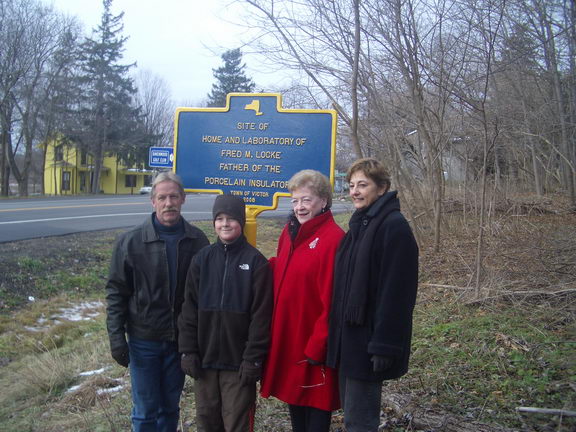
Fred M. Locke
Family History
Go back to Main Page

The village of Victor, NY dedicated this marker on November 29, 2008 to the accomplishments of Fred Locke 78 years after his death. The marker is located at the site of Fred's home and laboratory at 305 East Main St. Left to right in the photo are Jim Kimble (Sybil-Ann Kimble's son and Fred's great grandson and an avid insulator collector), James Bridgeford (Sybil-Ann's grandson, son of Cynthia Kimble Bridgeford and Fred's great, great grandson), Sybil-Ann Kimble (Fred's granddaughter and Jim Kimble's mother), and Babette Huber (Victor historian). Cynthia, Jim Kimble's sister, was not able to attend. Babette did a lot of research for me in 1992-1994 for my book about Fred Locke. She was also instrumental in getting the marker to honor Fred. Fred Locke's son, James Locke (who died in 1969) and father of Sybil-Ann, tried for many years in the 1960's to get the Village to honor his father. The effort was continued for many years by Sybil-Ann's husband, Melvin Kimble (who died in Nov. 2005).
Yes, Fred was the inventor of the porcelain insulator, which he worked incessantly to perfect, but he also developed glass formulas, which were essentially Pyrex glass. The earliest glass patents were made into insulators by Brookfield. The 1914 and 1916 glass patents were made into insulators by Corning. Some of these insulators were shipped to Italy. In 1919 he licensed two of his glass patents to Corning. Also in 1919, Fred licensed one of his glass patents to the Fry Glass Co., which was used for their Fryware baking dishes and dinnerware (check the patents on the bottom of the dishes). The license agreement forbid Fry from using the glass to make insulators, which lead Fry to develop their own glass formula for the famous Fry insulators. In 1925, Fred obtained another glass patent, which Corning developed into the line of Pyrex Flameware cooking dishes and today is used for stovetops and windows in the Space Shuttle. In 1934, Corning purchased all of Fred Locke's glass patents and laboratory experiment files, four years after his death.
Go to Fred Locke's First Insulators
Go back to Main Page